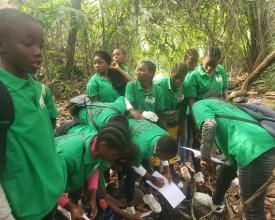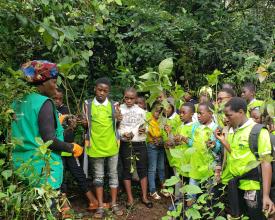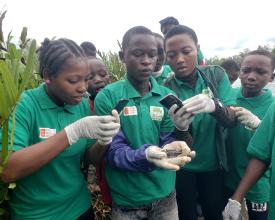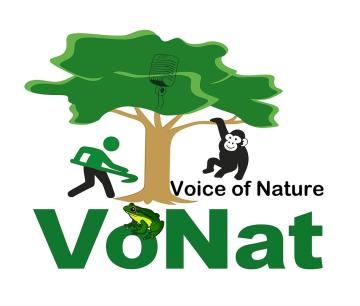
Empowering Children as Community Conservation and Climate Action Champions in Cameroon

Cameroon’s ecosystems face threats from deforestation, species loss, habitat degradation and climate change. Children and youth, among the most affected, are rarely included in conservation and climate initiatives. Voice of Nature (VoNat) empowers children aged 10–18 across four regions to become community conservation and climate action champions. The program integrates environmental education, storytelling, citizen science, and traditional knowledge, enabling children to conduct ecological studies, monitor biodiversity, document climate impacts, and lead awareness campaigns using arts, media, and community outreach. Over 10,000 children have been trained, fostering community-wide behavioral change, reviving traditional storytelling, strengthening partnerships with schools, families, and local leaders, and reducing destructive practices such as bush burning, hunting, deforestation, and waste dumping. This participatory approach transforms youth into active conservationists and climate leaders while promoting sustainability.
Context
Challenges addressed
Cameroon’s ecosystems face multiple challenges, including deforestation, habitat loss, species depletion, bush burning, pollution, and climate change, which threaten biodiversity and ecosystem services. Besides these, there is limited awareness and participation of children and youth in conservation, a disconnect from nature, and weak community engagement in environmental protection. This is compounded by unsustainable resource use, dependence on forest and mangrove products, and limited livelihood alternatives that drive harmful practices. Voice of Nature (VoNat) addresses these issues by empowering children aged 10–18 through environmental education, citizen science, storytelling, and community outreach. The program strengthens environmental knowledge, builds youth leadership, revives traditional practices for conservation, reduces destructive behaviors, and fosters sustainable community engagement, creating local stewards of biodiversity and climate resilience.
Location
Process
Summary of the process
The success of VoNat’s program relies on the interconnection of its key building blocks, which reinforce and amplify each other. Child-centered environmental education provides the knowledge foundation, which is enhanced by storytelling and creative media to communicate conservation messages in culturally resonant ways. Experiential learning and citizen science allow children to apply this knowledge in real-world contexts, fostering ownership and skill development. Community–school collaboration ensures that teachers, parents, and local leaders support and sustain engagement, while traditional knowledge integration connects conservation lessons to local heritage, increasing relevance and acceptance. Parental engagement and safeguarding maintain trust and ensure safe participation. Together, these components create a synergistic system where informed, motivated children become active conservation and climate champions, traditional practices are revitalized, and communities adopt sustainable behaviors, leading to long-term biodiversity protection and climate resilience.
Building Blocks
Child-centered Environmental Education
This building block recognizes that children hold the key to the future sustainability of our planet. They will one day shape laws, policies, and community decisions, yet they are already among the most affected by environmental challenges such as floods, heatwaves, water scarcity, and declining food security. Child-centered environmental education equips them with the knowledge, values, and skills needed to understand these issues and take informed action.
It works by placing children at the heart of learning, using age-appropriate, interactive, and locally relevant activities that spark curiosity and connect ecological concepts to their daily lives. Through games, storytelling, nature walks, and simple experiments, children explore how ecosystems function and why biodiversity must be protected. As parents often believe and listen more to their children, educating young people becomes a powerful indirect pathway to educate households and entire communities.
Because most participants are below 18, parental consent is always secured through consent forms that authorize participation and responsible use of images for professional purposes. By empowering children early and engaging families, this approach builds a strong foundation for long-term environmental stewardship and community-wide sustainability.
Enabling factors
Success requires;
- Trained, motivated educators.
- Age-appropriate, culturally and linguistically relevant materials.
- Safe and supportive spaces.
- Strong school–community collaboration.
- Active parental consent and involvement, and reliable funding are essential.
- Access to outdoor areas for experiential learning
- Words of affirmation, tips and snacks help boost interaction and active engagement.
- A feedback platform, such as a WhatsApp group with parents of participating kids for effective communication.
Lesson learned
Lessons Learned:
- Children learn best through games and hands-on exploration rather than theory-heavy sessions.
- Linguistic considerations that ensure that the children and youth are taught in the language they understand best or using interpreters in cases where the educators do not master the main language, enhance active participation and engagement
- Encouragement via tips, prizes and words of affirmation significantly increases participation and confidence.
- Engaging parents early and maintaining communication through platforms like WhatsApp groups strengthens trust and boosts continuity.
- Outdoor activities are essential but require careful planning to ensure safety and adequate supervision.
Challenges
- Inconsistent attendance due to class with school schedules.
- Limited teaching materials in some schools, and funding to support educators.
- Difficulty maintaining momentum without regular follow-up.
- In some cases, expectations for material incentives created dependency rather than genuine participation.
Advice
For anyone replicating this building block, it is crucial to work closely with teachers, secure parental consent early, manage expectations about incentives, and prepare flexible lesson plans that adapt to school schedules. Regular feedback loops with parents and educators help identify issues early and keep the program aligned with community needs.
Storytelling and Creative Use of Media Art Tools
This building block uses culturally rooted storytelling and creative media to make conservation learning memorable, relatable, and engaging. Older community members are invited to share folktales and stories about species, forests, and climate change, often recreating the traditional 3-stone fireside setting. This intergenerational exchange strengthens cultural identity while helping children understand ecological lessons through familiar narratives.
Children and young adults then transform what they have learned during experiential activities into creative media outputs such as poems, drawings, songs, open letters, and short articles. These materials become powerful advocacy tools used in radio and TV programs, newspapers, and community sensitization events. By actively creating and sharing content, children gain confidence, improve communication skills, and become visible ambassadors for conservation. This blend of tradition, creativity, and modern media ensures wider reach, deeper retention, and stronger community engagement in environmental protection.
Enabling factors
Success requires;
- Willing elders who can share folktales and culturally relevant stories that resonate with children.
- Trained facilitators to guide creative activities
- Access to safe spaces for storytelling is essential.
- Strong school–community collaboration and parental support
- Access to platforms such as radio, TV, or community events enable wider outreach.
- Encouragement, linguistic sensitivity, and consistent supervision help sustain engagement.
Lesson learned
Lessons Learned
- Involving elders creates cultural resonance and reinforces community identity.
- Children engage more deeply when traditional narratives and educational activities are combined with creative activities like drawing, poetry, songs, and articles.
- Media outputs strengthen retention and provide platforms for wider community sensitization.
Challenges
- Occasional scheduling conflicts with the elders
- Limited participation occurs when storytelling sessions are too long or complex.
- Limited resources and funding for sustainability replication
Advice
It is essential to plan sessions around elders' availability, provide simple but adequate media resources, offer guidance on creating media content, and balance storytelling duration with children's attention spans. Encourage iterative feedback to improve outputs and engagement.
Citizen Science and Experiential Learning
This building block enables children to apply knowledge gained through environmental education and storytelling in real-world contexts, fostering ownership, curiosity, and practical skills. Activities include observing local wildlife, ecological studies. monitoring plant growth, recording climate impacts, and participating in habitat restoration projects. Through hands-on engagement, children move beyond theory, developing problem-solving, critical thinking, and teamwork skills while seeing the tangible impact of their actions.
Citizen science elements allow children to contribute meaningful data to broader research efforts, connecting them to real conservation initiatives and reinforcing the relevance of their learning. This approach builds confidence, responsibility, and a sense of agency, transforming learners into active participants in protecting biodiversity and tackling environmental challenges. By combining experiential learning with structured data collection and reflection, children develop both practical skills and a lasting commitment to sustainable practices, while communities benefit from locally gathered insights.
Enabling factors
Success depends on;
- Access to safe outdoor spaces and natural habitats
- Trained facilitators to guide observations and experiments
- Proper orientation
- Age-appropriate field equipment and tools for data collection
- Strong school–community collaboration and parental consent and support
Lesson learned
Lessons Learned
Children learn best when they can directly observe, experiment, and interact with the environment
Citizen science projects increase motivation and ownership, especially when learners see their data contribute to real research or local conservation efforts.
Challenges
- Limited access to field sites and rugged terrains
- Unpredictable weather, and insufficient data collection tools.
- Limited funding for sustainability and scalability
Advice
It crucial to plan activities around accessible, safe sites, prepare flexible lesson plans, provide clear instructions and adequate tools, and secure strong school and parental support. Regular reflection and feedback sessions help children consolidate learning and maintain engagement throughout the program.
Resources
Impacts
VoNat’s program has delivered significant environmental, social, and economic impacts across four regions of Cameroon. Over 10,000 children and youth have conducted ecological studies, monitored biodiversity, and participated in planting over 10,000 trees in public spaces, water catchments, and degraded areas, contributing to restoring five critical water catchments, mitigating climate impacts and the protection of endangered species such as the Goliath Frog (Conraua goliath), Nigeria-Cameroon Chimpanzee (Pan troglodytes Elliot), and Preuss’ Monkey (Allotropes preussi), as well. Destructive practices, including bush burning, overharvesting, mangrove cutting, and improper waste disposal, have significantly decreased in participating communities. Children and youth have become local conservation champions, leading over 200 awareness campaigns, reviving traditional storytelling, and strengthening community cohesion through collaboration with schools, parents, and local leaders. Over 20,000 community members have been reached via media, open letters, and outreach activities. The program promotes sustainable resource use and alternative livelihoods, reducing dependence on harmful practices. By integrating education, citizen science, and creative outreach, the initiative builds long-term local capacity, fostering youth stewardship for lasting biodiversity conservation and climate resilience in Cameroon.
Beneficiaries
Over 10,000 children/youth aged 10–18 directly benefited from training in conservation, climate action, and storytelling. Over 20,000 community members and local schools in four regions of Cameroon indirectly benefited through awareness, sustainable practices.
Global Biodiversity Framework (GBF)
Sustainable Development Goals
Story
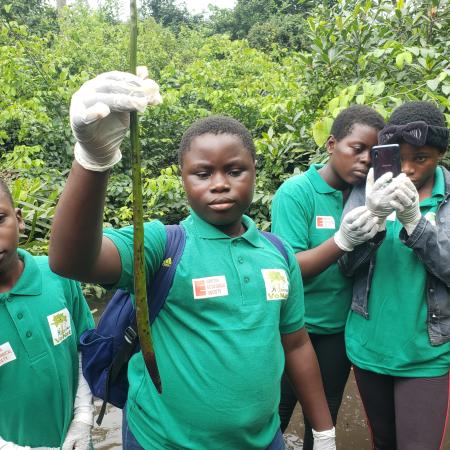
In 2025, Ngange Favor, a 14-year-old student from Buea in the Mount Cameroon Area, participated in an amphibian conservation education session. She described it as “a thrilling experience. We learned about different frogs, especially the Goliath Frog, Cameroon Reed Frog, and Lake Oku Frog. I will try my best to educate others about the importance of frogs.” During hands-on ecological studies, Ngange observed habitats, recorded species, and discovered how each frog contributes to ecosystem health, turning her curiosity into conservation action.
Similarly, Bonwe Favour in the Mount Cameroon Area shared after a storytelling session: “We learned about tree species and their medicinal uses, which helped me understand why trees must be conserved. I also learned about the close relationship between humans and chimpanzees, which changed my thoughts and made me value them more.” Through blending traditional storytelling with modern conservation science, children like Bonwe are reconnecting cultural identity with environmental stewardship.
In the Tiko Mangrove, Anyila Precious, aged 14, participated in ecological studies in 2023 and said, “I learned about the different mangrove species and biodiversity here. I discovered both red and white mangroves, locally called motanda. Using the iNaturalist app, I identified species and their conservation status. I now feel confident educating others in my community about mangrove protection.”
Further west in the Mount Mbam Area, Saidou Zulkifli, one of the participating youths in VoNat’s 2025 Youth Climate Action Campaign, shared: “This is my first time engaging in a tree-planting exercise. We came to show our community a good example, to plant trees and protect our environment. People are cutting trees without replanting, and this is bad for birds, animals, and even for us who need trees for shade and oxygen.”
These stories represent the heart of Voice of Nature (VoNat)’s child-centered conservation approach. Traditional rulers and educators are some of those already being impacted. As Chief Roland Essengue Mbonda of Mangamma remarked, “Conserving the frogs is a vital initiative. The destruction of one species affects the entire ecosystem. Everyone must be involved in protecting endangered frogs.”
From mountains to mangroves, VoNat's initiative has become a movement where children’s voices are shaping community mindsets, reviving traditional conservation values, and restoring hope for a greener Cameroon.




